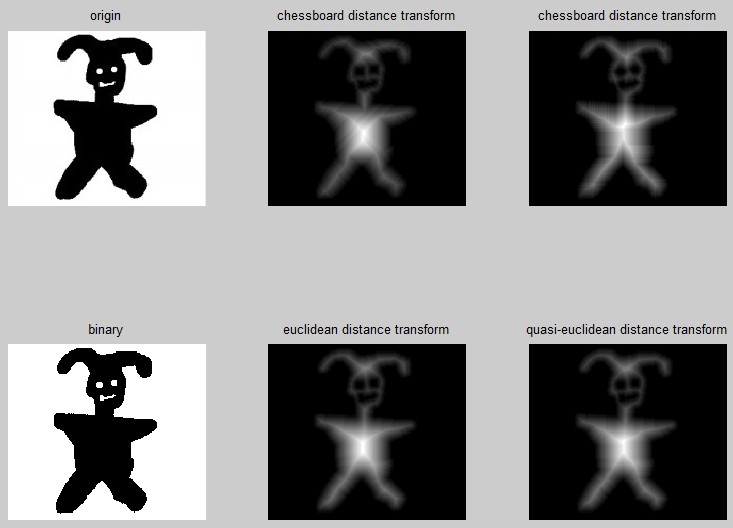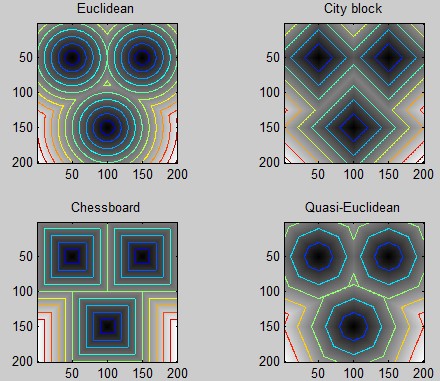分享一下我老师大神的人工智能教程!零基础,通俗易懂!http://blog.csdn.net/jiangjunshow
也欢迎大家转载本篇文章。分享知识,造福人民,实现我们中华民族伟大复兴!
距离变换和线性滤波器,形态学变换处于平等位置,是图像处理的一种方法,通过使用两遍扫描光栅算法可以快速计算到曲线或点集的距离。
应用:
水平集
快速斜切匹配
图像拼接
图像混合的羽化
临近点配准
方法:
首先对图像进行二值化处理,然后给每个像素赋值为离它最近的背景像素点与其距离(Manhattan距离or欧氏距离),得到distance metric(距离矩阵),那么离边界越远的点越亮。


实现:
Imgori=imread('test.jpg');I=rgb2gray(Imgori);subplot(2,3,1);imshow(I);title('origin');Threshold=100;F=I>Threshold;%front%B=I<=Threshold;%backgroundsubplot(2,3,4);imshow(F,[]);title('binary');T=bwdist(F,'chessboard');subplot(2,3,2);imshow(T,[]);title('chessboard distance transform')%the chessboard distance between (x1,y1) and (x2,y2) is max(│x1 – x2│,│y1 – y2│).T=bwdist(F,'cityblock');subplot(2,3,3);imshow(T,[]);title('chessboard distance transform')%the cityblock distance between (x1,y1) and (x2,y2) is │x1 – x2│ + │y1 – y2│.T=bwdist(F,'euclidean');subplot(2,3,5);imshow(T,[]);title('euclidean distance transform')%use Euclidean distanceT=bwdist(F,'quasi-euclidean');subplot(2,3,6);imshow(T,[]);title('quasi-euclidean distance transform')%use quasi-Euclidean distance
或者单纯想看这几个距离函数的区别可以用以下code:
bw = zeros(200,200); bw(50,50) = 1; bw(50,150) = 1;bw(150,100) = 1;D1 = bwdist(bw,'euclidean');D2 = bwdist(bw,'cityblock');D3 = bwdist(bw,'chessboard');D4 = bwdist(bw,'quasi-euclidean');figuresubplot(2,2,1), subimage(mat2gray(D1)), title('Euclidean')hold on, imcontour(D1)subplot(2,2,2), subimage(mat2gray(D2)), title('City block')hold on, imcontour(D2)subplot(2,2,3), subimage(mat2gray(D3)), title('Chessboard')hold on, imcontour(D3)subplot(2,2,4), subimage(mat2gray(D4)), title('Quasi-Euclidean')hold on, imcontour(D4)
给我老师的人工智能教程打call!http://blog.csdn.net/jiangjunshow
